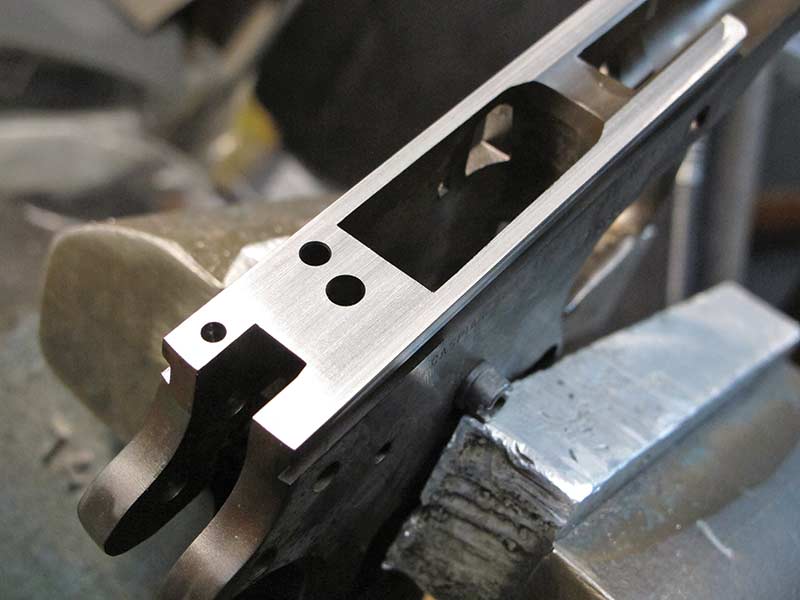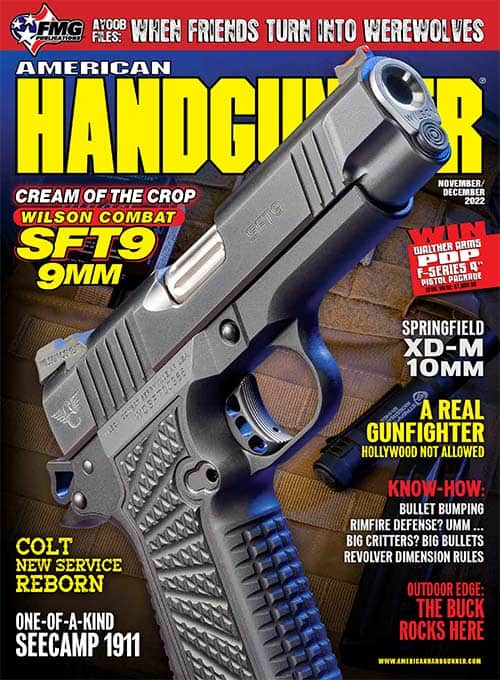Pistolsmithing Can Be a Grind
With the reintroduction of classic guns like the Colt Python and the Model P35 (Hi-Power) by Springfield Armory and FN, there is a growing need for custom parts for pistolsmiths to fill the needs of clients who want custom improvements.
John Harris of Harris Design has produced a line of sights for the new Colt “Snake” series of revolvers with adjustable sights. Harrison’s front and rear sights are larger for faster acquisition and alignment. They are taller too and will be offered in serrated steel, fiber optic, gold bead and tritium. The rear sights are larger and stronger, with a slightly wider notch to allow more light on each side of the front sight. Edges are rounded for a snag-free draw. The sight utilizes the factory sight housing, replacing the blade in the Colt base.
For the Hi-Power, I always turn to Cylinder and Slide. The Laughridge family has been making P35 parts for decades. Wide thumb safeties, no- bite hammers, beavertail and magwell blanks, along with lots of other parts. I like their thumb safeties available in ambidextrous or single side.
The long spur hammer on the P35 has been a pain (no joke) for many shooters who get hammer bit in the web of their hand; C&S offers eight different hammers. For sights, look at the Heinie and Novak offerings. Both make sights that are easy to see. The Hi-Power can be customized in many areas allowing shooters to tune the pistol to their needs. I’m sure the variety of custom parts will only increase with the renewed popularity of the Browning Hi-Power. Gunsmithing is required for most of the items I have mentioned. It’s usually best to find a pistolsmith with a good understanding of the pistol type needing work. A good source is the American Pistolsmith Guild website.
But what secrets do these pros use to perform their top-notch work? Let’s consider a couple of advanced techniques.
Surface Grinding
When you’re a custom pistolsmith, there is a lot of metal cutting — milling, filing, sanding and drilling. One of the best methods of metalworking is grinding. Not with a Dremel or bench grinder but with a surface grinder. A surface grinder removes precise amounts of steel, usually to within 0.0001″. That is one ten-thousandth of an inch. The grinder uses a spinning circular stone fixed to an arbor that moves vertically with great precision. The work moves under the spilling wheel on a sliding magnetic table. The stone or wheel can be moved up or down using an indexed wheel.
Surface grinding offers precision cuts and the resulting surface is glass smooth. I use the surface grinder to fit oversized 1911 slides and frames after material has been added via welding. The resulting fit is smooth and allows for less friction than traditional milling. Surface grinding is also used to flatten surfaces on steel parts. I have often used it to remove rollmarks on a semi-auto pistol slide before shipping them for engraving. With the right fixture, it can be used to shape sears and hammers. Anything that needs to be cut to a finished surface can be cut on a grinder. I’m not a master by any stretch, but I find it indispensable in my shop.
Filling the Voids
Micro welding is an art. Most of the fine-scale welding today is done with precision equipment like lasers. These are not cheap — costing tens of thousands of dollars. The skill is also very specialized. For these reasons, most pistolsmiths rely on specialists. One such specialist is Jim French in Georgia, who has been welding for years and recently acquired his FFL to work on firearms. I use Jim for all sorts of projects. Just recently, he welded cracks on an aluminum Colt 1911 frame. The cracks at the point where the dust cover meets the frame are not uncommon and usually fatal to the gun. Aluminum welding is difficult and even tougher on a small scale. Jim has also welded a few slides with Millett Dual Crimp sight holes. The holes are filled with weld and then I recut the slide for a new dovetail sight. This is on top of adding material to frames and slides to allow for a tighter fit after milling and grinding. Jim does a much neater job than I could with my large-scale welder.
Depending on the job, it can be well worth the money to pay a top pistolsmith. They’ve got the right tools and, more importantly, the right know-how.
For more info: JMFMicroweld.com, Cylinder-Slide.com, Heinie.com, NovakSights.com, AmericanPistolsmithsGuild.com, HarrisonCustom.com








